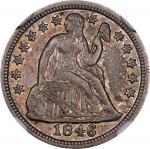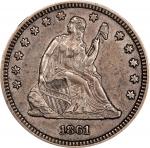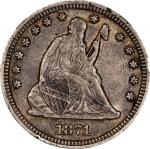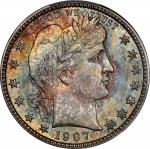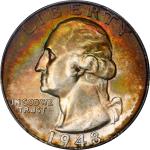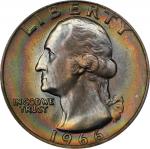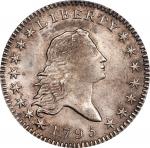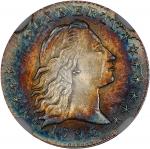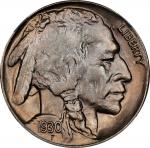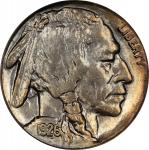1834 Capped Bust Dime. JR-1. Rarity-8 as a Proof. Large 4. Proof-64+ (PCGS).A gorgeous Choice Proof rarity, and a numismatically significant coin with links to the most famous Proof sets ever produced by the U.S. Mint. This is a universally semi-reflective specimen with full, razor sharp striking detail throughout the design. The surfaces are further enhanced by pretty toning in soft, iridescent golden-gray that yields to brighter champagne-pink and powder blue under direct lighting. There are no troublesome handling marks, and were it not for a trivially muted finish this premium specimen would undoubtedly have secured a full Gem Proof grade from PCGS. Strong doubling is evident at several of the obverse stars, especially those at left.<p>The 1834 dime as an issue is a major numismatic rarity in Proof format with only eight to 10 specimens believed extant (per <em>PCGS CoinFacts</em>). These coins represent five die pairings, astonishing when studied with knowledge of later U.S. Mint Proof coinage, but understandable - indeed normal - for the 1830s when Proofs were made in small numbers, upon request, at several different times throughout the year. Only three Proofs from the JR-1 dies are reported, and insofar as coinage of the Large 4 <em>Guide Book</em> variety preceded that of the Small 4, the Proofs are also believed to have been prepared early in the year. Interestingly, however, the dime in the famous King of Siam Proof set is from the JR-1 dies, although the special diplomatic sets of that year were not ordered by Secretary of State John Forsyth until November 11, 1834. As Walter Breen conjectures in the 1989 edition of his Proof coin encyclopedia:<p><em>The large 4 is known on other grounds to have preceded the small 4, so if the large 4 type was found in the Siam set, this presumably means that coins were left over and remained available, rather than specifically struck late for the purpose.</em><p>We may never know for sure, but the offered coin may have once been part of the Sultan of Muscat Proof set, prepared at the same time and for the same purpose as that of the King of Siam. The latter was broken up, however, portions finding its way into the hands of wealthy Liverpool, England merchant Charles A. Watters in 1867 or 1868, under unknown circumstances. Glendining and Co., a London auction house, was selected to sell "the property of C.A. Watters, Esq, Liverpool" in two sales. The first, held in May 1917, focused on Watters extensive and well-known collection of English coins. The second sale, held on June 14 and 15 of the same year, included Watters collection of coins of the Isle of Man, which incorporated scholar Philip Nelsons entire collection of Manx coins, along with coins from other British possessions, and some Greek and Roman pieces. The second days sale offered mostly American coins and medals, beginning with a 1652 New England shilling that had come from the famous Nelson cabinet. The following 138 lots ranged widely in quality and rarity, a hodgepodge that included an 1855 $50 Wass, Molitor gold piece, an 1836 Gobrecht dollar, and a lot of 22 circulated three-cent silvers. Watters was a collector of substantial means, dying in 1932 with an estate worth in excess of £13,000, but his American cabinet was a miscellany, formed with neither completion nor condition in mind. The announcement of the sale made at the 60th annual meeting of the American Numismatic Society in January 1918 detailed many of Watters numismatic specialties but didnt even mention that any American coins were sold.<p>Lot 227 stood out, earning more description over its three and a half lines of text than any other lot sold that day:<p><em>AR Dollar, 1804, excessively rare, in perfect condition, considered one of the finest specimens known. See plate. Shows the same slight flaw in die at the top of the letters in Liberty as the Parmelee specimen.</em><p>On its own, such a coin would stick out prominently in a collection like Watters. But in the next few dozen lots, among the holed 1807 quarter, the Proof coins of the 1880s and 1890s, and the large lot of circulated nickels, were coins that arranged like a constellation around the Watters 1804 dollar, forming something together that was greater than the sum of their parts. Lot 240 included eight half dollars, all of which were graded "fine," dated from 1836 to 1846, but for one: "1834, proof." Lot 246 offered 10 quarter dollars, an assortment from 1836 to 1856 that included a single New Orleans Mint issue and all graded "very fine" but one: "1834, proof." Lot 254 was an unspectacular dozen half dimes, including a 1795 called "good," 10 pieces from 1829 to 1834, including several duplicates, called "very fine," and another half dime that seemed not to belong: "1834, a proof." While the gold was nowhere to be seen, clearly Watters owned most of an 1834 Proof set. If he owned the dime, cent, and half cent that went with it, they were unappreciated and mixed into other lots, namely lot 250 (nine dimes, including an 1834), lot 278 (23 cents from 1821 to 1839) and lot 283 (20 half cents from 1809 to 1857). What Watters had acquired, probably in London about 1867, was the remains of a set of United States coins distributed in 1834 by the United States Department of State. Watters had purchased what was left of the set given to the Sultan of Muscat on October 1, 1835.<p>The whereabouts of the Sultan of Muscat-Watters Proof 1834 half dime is unknown or, at least, none of the confirmed specimens have been traced back to the Watters sale. Of course, it is also possible that the provenance of the present Proof 1834 JR-1 is far less regal, it perhaps numbering among the few Proofs of the date acquired by early American collectors. The link by die marriage to the King of Siam specimen is indelible, however, and the theory of a definitive link to the Sultan of Muscat Proof set is a compelling one. When combined with this coins awesome rarity both as a pre-1840 U.S. Mint Proof coin and a Proof striking of the 1834 JR-1 dime, these links propel the importance and desirability of this specimen to new heights.PCGS# 4556. NGC ID: 27D6.PCGS Population (all die marriages of the Proof 1834 dime): 1; 3 finer (Proof-67 finest).






